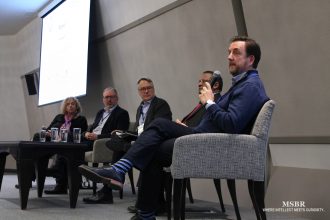As President Obama and Congress try to reduce the fiscal cliff to a mere “fiscal incline,” so as to avoid the shock of going through painful austerity measures all at once, many alternative solutions to the United States’ economic and fiscal woes are being overlooked. While both Democrats and Republicans will most certainly call for their own versions of dramatic fiscal reforms, the best possible options to simultaneously reduce deficits and return America to full employment may not even be on the table. America may have expensive problems, but that does not mean the solutions will have to be painful.
In the New York Times article “Nation’s Choices Needn’t Be Painful,” Robert H. Frank, economics professor at Cornell University, calls for a cocktail of remedies that will both stimulate the economy in the short-term and set the Federal Government on a path toward a balanced budget in the long-term. These remedies include accelerated infrastructure spending and the gradual introduction of carbon, congestion and consumption taxes.
Accelerating infrastructure spending will provide a quick stimulus to the slowly recovering American economy and provide much-needed improvement to crumbling American bridges, highways, waterways and airports that cash-strapped states and municipalities have not been able to properly maintain since their budgets were hit by the 2007-2009 recession. These infrastructure improvements become more expensive over time as they continue to crumble into disrepair, so the federal government should jump on this opportunity to save money in the long-run.
The farthest-reaching folly that brought about the fiscal cliff is the prevailing narrative in the United States that suggests that the biggest threat to American prosperity is its crippling debt. In the short term, debt is not the issue that threatens America’s sustainability the most. The struggling workforce crawling back to a precarious full employment has more far reaching consequences including less revenue for the federal government over time. In the short term, unemployment and underemployment should and must be the focus of Congress’s attention. Increasing taxes now will immediately decrease the amount of money that goes into Americans’ pockets and will slow the recovery even further. By phasing in taxes in several years, after giving the economy more time to recover, Frank argues that the government accomplishes two things: “First, anxious credit markets would be reassured about the nation’s capacity to pay down government debt. And second, the delayed new taxes would speed the recovery by encouraging immediate increases in private spending.”
What should the American government tax? Taxes serve two purposes: they generate revenue and they provide disincentives to participate in the actions that are taxed. Current taxes include income taxes and payroll taxes, which disincentivize working, but is there a workable alternative? Consumption taxes have generated some discussion in the past but have not been given enough consideration. A steeply progressive tax on consumption, calculated by taking a given percentage of income minus savings, would both incentivize savings and investment and generate a new source of revenue for the federal government.
Though a carbon tax is seen as damaging toward some industries, if its implementation were delayed by several years, it could force investment in technological advances that would offset the costs of the tax. A congestion tax could help reduce road congestion and pay for further infrastructural improvements. Other taxes such as a tax on sugary drinks have been offered in Congress but have yet to generate enough traction to make it to the President’s desk.
America is faced with some expensive choices, but these choices do not have to endanger the economic recovery. Austerity measures will only further deleverage an already fragile economic recovery. The fiscal cliff is a product of politics, not sound economic theory.


